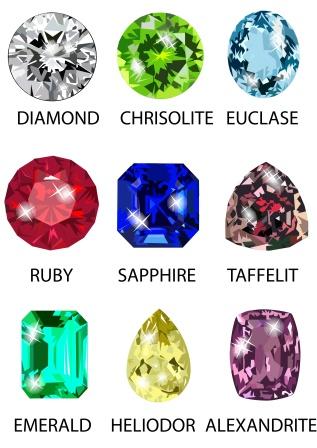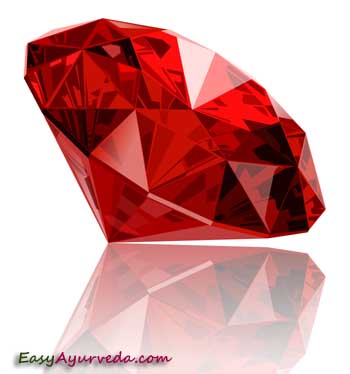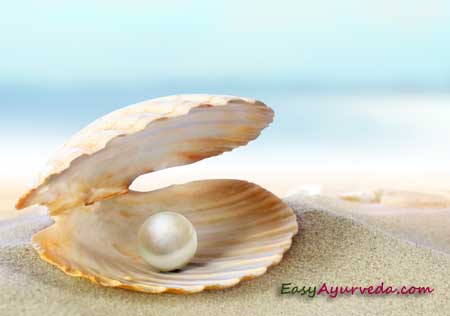Ratna (Gemstones): Introduction, Types, Qualities, Ayurvedic Uses
Ratnas or Gems are the precious stones which symbolize wealth and power. Gems are commonly used in the preparation of jewels. But in Rasashastra gems are being used for medicinal purposes after proper purification properties.
Table of Contents
Introduction
Gems are used extensively in Ayurvedic medicines. Gems are called Ratna. The term Ratna is coined due to their unique, radiant and appealing outlook when compared to other natural minerals. There are nine Ratnas and eight uparatnas (sub-gems) mentioned in Ayurvedic treatise.
Definition
धनार्थिनो जनाः सर्वे रमन्तेऽस्मिन्नतीव यत् ।
अतो रत्नमिति प्रोक्तं शब्दशास्त्रविशारदैः ॥
(आयुर्वेदप्रकाश, ५/२)
dhanārthino janāḥ sarve ramante’sminnatīva yat |
ato ratnamiti proktaṃ śabdaśāstraviśāradaiḥ ||
(āyurvedaprakāśa, 5/2)
The thing which attracts people who wish to become rich, is called Ratna or Gem stone.
We can find references to various Ratnas in textbooks of rasashastra.
मणयोऽपि च विग्नेयाः सूतबन्धनकारकाः ॥ (र.र.स.४/१)
देहस्य धारका नृणां जरा व्याधिविनाशकाः ।
जातौ जातौ यदुत्कृष्टं तद्धि रत्नं प्रचक्षते । (रघुवंश)
धन्नर्तिनो जनाः सर्वे रमन्तेऽस्मिनतीव यत ।
अतो रत्नमिति प्रोक्तं शब्दशास्त्रविशारदै ः ॥ (आयु प्र ५/२)
कुलिशं केनापि नो लिख्यते ।
maṇayo’pi ca vigneyāḥ sūtabandhanakārakāḥ || (ra.ra.sa.4/1)
dehasya dhārakā nṛṇāṃ jarā vyādhivināśakāḥ |
jātau jātau yadutkṛṣṭaṃ taddhi ratnaṃ pracakṣate | (raghuvaṃśa)
dhannartino janāḥ sarve ramante’sminatīva yata |
ato ratnamiti proktaṃ śabdaśāstraviśāradai ḥ || (āyu pra 5/2)
kuliśaṃ kenāpi no likhyate |
A gemstone or gem (also called a precious or semi-precious stone, or jewel) is a piece of attractive mineral, which-when cut and polished-is used to make jewelry or other adornmentsThe gems are precious stones, having a special kind of shining. In Hindu belief, the ratnas mitigate the bad effects of Navagrahas.

The 9 gems
The nine Ratnas mentioned in our classics are associated with the nine Grahas. They are as follows –
Maanikya – Ruby – affects on Soorya / Sun.
Mukta – Pearl – affects on Chandra/ Moon.
Pravala – Coral – Mangala/ Mars
Tarkshya – Emerald – Budha/ Mercury
Pushparaga – Topaz – Guru/ Jupiter
Vajra – Diamond – Shukra/ Venus
Neela / Indraneela – Sapphire – Shani/ Saturn
Gomeda – Zircon – Rahu/ Ascending lunar node
Vaidoorya – Cat’s eye – Ketu/ Descending lunar node
| Sl.No. | Ratna | English name | Navagraha | Hardness | Specific Gravity | Chemical Formula |
| 1. | Manikya | Ruby | Soorya | 9 | 4 | Al2O3 |
| 2. | Muktaphala | Pearl | Chandra | 3.5 | 2.4 – 2.78 | CaCO3 |
| 3. | Vidruma (Pravala) | Coral | Mangala | 3.5 | 2.60 – 2.70 | CaCO3 |
| 4. | Tarkshya (Panna) | Emerald | Budha | 7.50 | 2.71 | Be3Al2(SiO3)6 |
| 5. | Pushparaga | Topaz | Guru | 8 | 3.5 | Al [FOH]2SiO4 |
| 6. | Bhidura (Heeraka) | Diamond | Shukra | 10 | 3.5 | C |
| 7. | Neelama | Sapphire | Shani | 9 | 4 | Al2O3 |
| 8. | Gomeda | Zircon | Rahu | 7.25 | 3.5 | ZrSiO4 |
| 9. | Vaidoorya | Cat’s eye | Ketu | 8.5 | 3.5 | BeOAl2O3 |
Gems in Astrology
In Astrology, it is believed that a person’s health and well-being is determined by the Grahas.
The effect of respective gems to specific Grahas is already explained in the table above.
Every cell in the human body is ultimately made up of electrons and nucleus. Just like the electrons orbit round the nucleus, so do the planets revolve around the Sun. Considering ‘Loka Purusha Samya’ concept here, it can be inferred that planets can have a major effect on Homo sapiens at quantum level.
These gems can draw energy from their particular Graha and channelize them into the wearer’s body. Thus they correct the deficit aura and help to subside the disease.
If this method of Dharana (Wearing) of Ratnas can be such a boon to cure diseases, it has another facet of mitigating and rejuvenating the body through internal administration as well. This has been mentioned in Rasa shastra texts. They can be converted into three forms for consumption –
Bhasma – calx,
Pishti – paste and
Dhruti – liquid / melted form.
Uses of gems in Ayurveda
रसे रसायने दाने धारणे देवतार्चने ।
सुलक्ष्याणि सुजातीनि रत्नन्युक्तानि सिद्धये ॥ (र.र.स. ४/७)
rase rasāyane dāne dhāraṇe devatārcane |
sulakṣyāṇi sujātīni ratnanyuktāni siddhaye || (ra.ra.sa. 4/7)
Good quality Ratnas are used in processing of Parada, for rejuvenation, for donation, in worshiping Deities.
Significance of Pishti
Ratnas are well known to be of Sheeta guna and are heat sensitive. In order to preserve their Sheetatva , Anagni puta is given by triturating them in liquid media and exposing to Sun till the required Lakshanas are obtained. By this method, not only is its potency preserved but one can convert them into nanoparticle size which is desired for better absorption and assimilation.
Types
- Khanija 2. Pranija 3. Vanaspatika
Mineral origin: Manikya, Tarkshya, Vajra, Neelam etc. - Animal origin: Mukta, Pravala etc.
- Herbal origin: Trunakanta mani, Sangemusha.
Good qualities of Ratnas:
Rarity
Hardness
Beauty
Durability
Attractive colour
Undesirable qualities of Ratnas:
- Grasa: If half of the gem is opaque or blackish in color, it is considered to have Grasa Dosha.
- Trasa: If half of the gem is having a different color, it is considered to have Trasa Dosha.
- Bindu: If the gem has particles of other ratnas mixed in it, it is considered to have Bindu Dosha.
- Rekha: When there are streaks on the gems, it is considered to have Rekha Dosha.
- Jalagarbhata: If the gem has an air / water bubble, it is considered to have Jalagarbhata Dosha.
Gems with the above mentioned defects are low in price and quality. Such gems are cut before usage.
Manikya (Ruby)

Ruby is one among the precious stones. The ruby is a pink to blood-red coloured gemstone, a variety of the mineral corundum (Aluminium oxide). The red color is caused mainly by the presence of the element chromium. Its name comes from ruber, Latin for red.
Types
Padmaragaakhya Neelagandhi.
Qualities
माणिक्यं मधुरं स्निग्धं वृष्यं हृद्यं च दीपनम् ।
मेद्यं रसायनं बल्यं वातपित्त क्षयार्तिनत् ॥ (रसामृत)
māṇikyaṃ madhuraṃ snigdhaṃ vṛṣyaṃ hṛdyaṃ ca dīpanama|
medyaṃ rasāyanaṃ balyaṃ vātapitta kṣayārtinut || (rasāmṛta)
Sweet in taste, unctuous, aphrodisiac, strengthens heart, improves digestion, intelligence, strength, rejuvenative, cures Kshaya disease and calms Vata & Pitta.
Read more: Manikya (Ruby): Types, Qualities, Shodhana, Marana, Dosage
Mukta (Pearl)

Mukta or Pearl is an organic gem, which is obtained from the Pearl shell or oyster found in the sea. It is classified under Ratna Varga or group of precious gems. It is white coloured, shining, hard spherical object found in sea shells. Due to its attractiveess it is widely used in jewelry and cosmetics.
Types
Depending upon yoni or origin:
• Sukthi mothi – Which is obtained from sea shell
• Shanka mothi – Which is obtained from conch shell
• Gaja mothi – Which is obtain from elephant
• Kroda mothi – Which is obtain from pig
• Phani mothi – Which is obtain from snake
• Mathsya mothi – Which is obtain from fish
• Dardura mothi – Which is obtain from frog
• Venu mothi – Which is obtain from bamboo
Modern classification:
• Natural pearl – naturally obtain in sea shell
• Cultured pearl – here sea shell are cultured & pearl is obtained
Mukta Properties
Rasa – Madhura
Guna – Laghu, Shishira
Virya – Shitha
Vipaka – Madhura
Doshaghnatha – Kapha, Pitta
Indications of pearl gem (Mukta)
- Varnya – improves complexion,
- agnipustikara – enhances digestion power,
- vishahara – anti-poisonous,
- bhedi – purgative,
- viryaprada – increases virility,
- deepana – carminative,
- pachana – digestive,
- ruja hara – subsides pain,
- ashukara – acts quickly,
- kasa hara – cures cough,
- swasa hara – cures dyspnea,
- vrushya – aphrodisiac,
- ayushya – increases lifespan,
- dahagna – subsides burning sensation,
- netrya – good for eyes,
- jeerna jwara prashamana – cures chronic fever,
- asthi dantha vivardana – strengthens teeth and bone,
- hradya – cardiotonic,
- meha hara – cures urinary disorders,
- medhya – enhances intelligence,
- dantha bedhapaham – subsides splitting pain in the tooth,
- jvarapaham – cures fever,
- kshaya hara – helpful in depletion of body tissues,
- parikopa nashanam – keeps away anger,
- asthi shosha shamanam – corrects degeneration of bone.
- Read more: Mukta (Pearl): Types, Properties, Shodhana, Marana, Dosage
Pravala (Coral)
Pravala or coral is a precious gem, which comes under Navaratnas (group of nine precious gems). It is opaque and red in color. Corals are gastrovascular marine cnidarians (phylum Cnidaria; class Anthozoa) existing as small sea anemone-like polyps, typically forming colonies of many individuals. Coral is a natural calcium source used in Ayurvedic treatment of varieties of disorders.
Types
Based on color –
- Rakta
- Shweta
- Krushna
- Dyusara
Among these, Rakta Pravala is considered the best.
Based on part used – - Pravala mula (Basal part)
- Pravala kanda (Porous tube-like branches)
Qualities
क्षयपित्तास्रकासघ्नं दीपनं पाचनं लघु ।
विषभूतादिशमनं विद्रुमं नेत्ररोगनुत् ॥ (र.र.स. ४/१९)
kṣayapittāsrakāsaghnaṃ dīpanaṃ pācanaṃ laghu |
viṣabhūtādiśamanaṃ vidrumaṃ netraroganut || (ra.ra.sa. 4/19)
Useful in the treatment of –
Kshaya – depletion of body tissues,
Raktapitta – bleeding disorders,
Kasa – cough,
acts as digestive, antitoxic, light in nature, useful as diuretic, good for eyes.
Read more about Pravala here
Marakata (Tarkshya/Emerald)
It is a green gem. It calms Budha Graha. It is a compound of Silica, Beryllium and Oxygen. Relative density – 2.72 and hardness – 7.5
Types
Based on colour, it is of four types.
- Brahmana Varna – Colour similar to the flower of Shireesha.
- Kshatriya Varna – Deep green colour
- Vaishya Varna – Greenish with yellow tinge.
- Shudra Varna – Grayish tinge.
Qualities
ज्वरच्छर्दिविषश्वाससन्निपाताग्निमान्द्यनुत् ।
दुर्नामपाण्डुशोफघ्नं तार्क्ष्यमोजोविवर्धम् ॥ (र.र.स. ४/२२)
jvaracchardiviṣaśvāsasannipātāgnimāndyanut |
durnāmapāṇḍuśophaghnaṃ tārkṣyamojovivardhanam || (ra.ra.sa. 4/22)
Marakata is useful in the treatment of Jwara, Chardi, Visha, Shwasa, Sannipata, Mandagni, Arsha, Pandu and Shotha. It increases Ojus.
Read more about Marakata here
Pushparaga (Topaz)
Pushparaga is a Maharatna which belongs to the Kuruvind category. Its specific gravity is 3.5 and sclerosis is 8. It is a combination of aluminum and sand.
Types
There are no types explained in Rasa texts. Based on colour, they can be classified as –
1. Yellow
2. White
3. Red
4. Gray
Qualities
Deepana, light, digestive, useful in Visha, Chardi, Kapha, vata, Agnimandya, Daha and Kushta.
Read more about Pushparaga here
Heeraka (Diamond)
Diamond is one of the best-known and most sought-after gemstones. Diamonds have been known to humankind and used as decorative items since ancient times; some of the earliest references can be traced to India.Diamond’s hardness and high dispersion of light – giving the diamond its characteristic “fire” – make it useful for industrial applications and desirable as jewelry.
Diamonds are such a highly traded commodity that multiple organizations have been created for grading and certifying them based on the four Cs, which are carat, cut, color, and clarity. Other characteristics, such as shape and presence or lack of fluorescence, also affect the desirability and thus the value of a diamond used for jewelry.
Types
Vajra is of 3 types –
- Nara (best)
- Nari (medium quality)
- Napumsaka (bad)
Each of these has four types –
- Brahmana (white colour)
- Kshatriya (red coluor)
- Vaishya (yellow colour)
- Shoodra (black colour).
Qualities
आयुष्प्रदं झटिति सदगुणञ्च वृष्यं दोषत्रयप्रशमनं सकलामयघ्नम ।
सूतेन्द्रबन्धवधसदगुणकृत्प्रदीपनं मृत्युञ्जयं तदमृतोपममेव वज्रम ॥ (र.र.स. ४/३२)
āyuṣpradaṃ jhaṭiti sadaguṇañca vṛṣyaṃ doṣatrayapraśamanaṃ sakalāmayaghnama |
sūtendrabandhavadhasadaguṇakṛtpradīpanaṃ mṛtyuñjayaṃ tadamṛtopamameva vajrama || (ra.ra.sa. 4/32)
Improves age, Tridoshahara, Rasayana, strengthens body, useful in treatment of Shosha, Kshaya, Bhagandara, Prameha, Pandu and Shotha.
Read more about Heeraka here
Neelam (Sapphire)
It is a compound of Aluminium and Oxygen with traces of Cobalt. It calms Shani graham. Specific gravity -4
Hardness – 9.
Types
- Shakraneela (Indraneela) – which is dark blue in colour, heavy. It is considered as suitable.
- Jalaneela – which is white in colour, lighter.
Qualities
कासश्वासहरं वृष्यं त्रिदोषघ्नं सुदीपनम ।
बल्यं मेद्यं विषहरं हृद्यं चैव रसायनम ॥ (रसामृत)
श्वासकासहरं वृष्यं त्रिदोषघ्नं सुदीपनम ।
विषमज्वरदुर्नामपापघ्नं नीलमीरितम ॥ (र.र.स. ४/५३)
kāsaśvāsaharaṃ vṛṣyaṃ tridoṣaghnaṃ sudīpanama |
balyaṃ medyaṃ viṣaharaṃ hṛdyaṃ caiva rasāyanama || (rasāmṛta)
śvāsakāsaharaṃ vṛṣyaṃ tridoṣaghnaṃ sudīpanama |
viṣamajvaradurnāmapāpaghnaṃ nīlamīritama || (ra.ra.sa. 4/53)
Aphrodisiac, Tridoshaghna, useful in Kasa, Shwasa, improves strength, intelligence, Vishahara, Hrudya, rasayana.
of Gandhaka, Haratala and Manashila with Nimbuswarasa bhavana, cakes are prepared and subjected to 8 Putas of heat.
Gomeda (Zircon)
Its colour is similar to the fat of a cow. So the Name Gomeda. It calms Rahu graham. Specific gravity – 3.5 and Hardness 7.25
Types
As per modern classification, based on colour, it is classified into white, green, blue, yellow, red and grey colours.
Qualities
गोमेदं कफपित्तघ्नं क्षयपाण्डुक्षयड करम ।
दीपनं पाचनं रुच्यं त्वच्यं बुद्धिप्रबोधनम ॥ (र.र.स. ४/५६)
gomedaṃ kaphapittaghnaṃ kṣayapāṇḍukṣayaḍa.karama |
dīpanaṃ pācanaṃ rucyaṃ tvacyaṃ buddhiprabodhanama || (ra.ra.sa. 4/56)
Gomeda is good in kapha pitta conditions, anemia, digestive, carminative, improves taste, good for skin and improves intelligence.
Read more about Gomedaka here
Vaidoorya (Cat’s Eye)
Its appearance is similar to the eye of Cat. So the name is Cat’s eye or Vidalaksha. Its main chemical ingredients are Aluminium and Beryllium with traces of Iron and Chromium. It calms Ketu graham. Specficig gravity 3.5 Hardness 2.5
Types
Types are not mentioned in rasashastra texts but according to modern science, it is of two types
- Cat’s eye
- Alexandride
Qualities
दीपनं मेध्यमायुष्यं बल्यं च मलभेदनम ॥
रक्तपित्तप्रशमनं चक्षुष्यं बृंहणं परम ।
पित्तामयप्रशमनं समाख्यातं वेशेषत: ॥ (र.त.२३/११७ – १८)
dīpanaṃ medhyamāyuṣyaṃ balyaṃ ca malabhedanama ||
raktapittapraśamanaṃ cakṣuṣyaṃ bṛṃhaṇaṃ parama |
pittāmayapraśamanaṃ samākhyātaṃ veśeṣata: || (ra.ta.23/117 – 18)
Digestive, improves intelligence, age, Bala, useful in Raktapitta and such other Pitta disorders.
read more about Vaidurya Uses, Purification, benefits.









